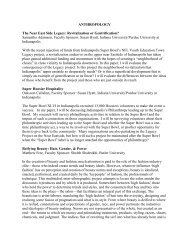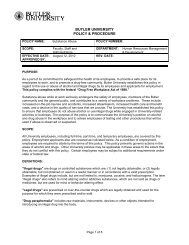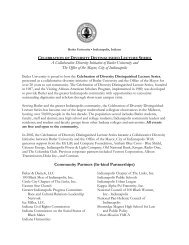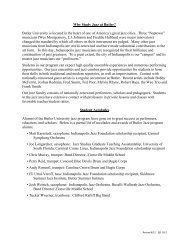ROWing Through Fall Creek - Butler University
ROWing Through Fall Creek - Butler University
ROWing Through Fall Creek - Butler University
Create successful ePaper yourself
Turn your PDF publications into a flip-book with our unique Google optimized e-Paper software.
idor. Honeysuckle is an invasive plant in Indiana and throughout the states. It is in many cases creates a<br />
monoculture by choking out all other native plants. Honeysuckle hurts ecosystems in that it diminishes native<br />
plants and hurts plant species diversity. It outcompetes natives by growing quickly and growing tall. It<br />
shades other understory species and is spread easily by birds, which enjoy its red berries.<br />
The honeysuckle metric is aimed at providing a base measure for honeysuckle coverage before any removal<br />
interventions are established. The numbers of honeysuckle stems in sixteen-five by three yards plots were<br />
counted. Eight of these plots were in a section of <strong>Fall</strong> <strong>Creek</strong> that is not maintained in any way. The other<br />
eight were in a section that is a designated as park area and is maintained by invasive species removal and<br />
herbicide application.<br />
The honeysuckle stem count was much greater in the non-maintained section of <strong>Fall</strong> <strong>Creek</strong>, compared to<br />
the maintained section. The honeysuckle in this area is abundant and covers most of the other vegetation.<br />
In the maintained section, there is almost no honeysuckle cover, but there is also not much other understory<br />
vegetation. It appears that the methods used in order to diminish honeysuckle cover may have also diminished<br />
native species in the area.<br />
The final metric that will be used to assess ecology is a water quality assessment. This will take into consideration<br />
a combination of factors that influence water quality. The class contacted the Marion County Health<br />
Department, who compiles water quality tests that have been conducted over the past five months along the<br />
Mapleton/<strong>Fall</strong> <strong>Creek</strong> sector.<br />
The water quality assessment for <strong>Fall</strong> <strong>Creek</strong> includes the total dissolved solids, dissolved oxygen, nitrates,<br />
and E.coli samples. The total dissolved solids of a river is a good indication of the health of that river, but<br />
in this case, it may be difficult to conclude results solely from this factor because there are a number of combined<br />
sewage overflow sites along this sector of the River, which will have a major impact on our test results.<br />
If there is an excess of total dissolved solids, it may be too dense and difficult for sunlight to penetrate the<br />
water and reach plants at the bottom, thus preventing photosynthesis from happening. If there is a lack of<br />
total dissolved solids in the water, it is possible for too much sunlight to penetrate the water and excel photosynthesis<br />
to an unhealthy level, and also increase the temperature of the water, which adversely affects all<br />
organisms in the water. Total dissolved solids are often introduced to the <strong>Creek</strong> through runoff, lawn fertilizer,<br />
animal waste, and soil erosion.<br />
E.coli is typically introduced to the <strong>Creek</strong> by animal waste, and human waste when the combined sewer<br />
overflows are opened during periods of heavy rain. E.coli is a bacterium that can cause illness and death if<br />
not treated. It is important for recreational walkers to pick up animal waste along the <strong>Creek</strong> in order to avoid<br />
or decrease the introduction of E.coli into the <strong>Creek</strong>. It is especially important to understand the E.coli levels<br />
in <strong>Fall</strong> <strong>Creek</strong>, in order to inform the public when and when not to visit the <strong>Creek</strong> or go near the water.<br />
Typically, the E.coli levels will be higher after a rainfall and if the CSO system is active (EPA).<br />
Dissolved oxygen varies seasonally, such that cold water holds more and warm water holds less. Dissolved<br />
oxygen is extremely important for the survival of plants and animals living in the <strong>Creek</strong>. If there is not<br />
enough dissolved oxygen in the water, it may indicate that not enough photosynthesis is occurring, which<br />
means other organisms in the water are not able to maintain sufficient oxygen to survive, and they can literally<br />
suffocate. Most static bodies of water maintain a healthy amount of dissolved oxygen because the<br />
movement of the water draws in oxygen. However, the CSO system in the MFCN emits many undesirable<br />
pollutants into the <strong>Creek</strong>, and those pollutants often use the oxygen in the water, leaving very little for the<br />
9 Environmental Practicum :: <strong>Fall</strong> 2012

















